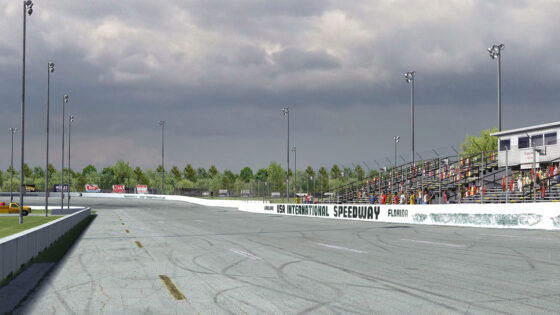When NASCAR announced it was bringing racing back to The Rock in 2025, fans went wild. “It has everything a race fan desires,” said Bob Sargent, President and CEO of Track Enterprises. The Rockingham Speedway, a legendary North Carolina oval, is one of those gritty old-school tracks drivers and diehards never wanted to see disappear. The Xfinity and Truck Series headed back there this season, felt like a long-overdue homecoming. But who facilitated this comeback?
The North Carolina state government allotted a whopping $50 million. It was meant to renovate three speedways: Charlotte, North Wilkesboro, and the ‘Rock’. Rockingham, among them, received $9 million. Furthermore, the NASCAR event at Rockingham was sponsored by Black’s Tire for an undisclosed amount.
But while Rockingham gets its redemption arc, not every beloved short track has been so lucky. Over the years, NASCAR’s landscape has quietly shifted. Some hometown ovals that once roared with late models and stock cars have vanished without a trace. And in one Florida city, the rumble of engines was replaced by the hum of conveyor belts and a NASCAR sponsor worth nearly $2 trillion.
The rise and fall of the USA International Speedway
In the mid-1990s, USA International Speedway emerged in Lakeland, Florida, as a premier 0.75-mile oval track. With 14° banked turns and a seating capacity of 6,500, it quickly became a hub for racing enthusiasts. The track hosted a variety of events, including the USAR Hooters Pro Cup Series, ASA National Tour, and even NASCAR Southeast Series races. Legends like Joey Logano and James Buescher showcased their talents here, making it a cornerstone of Florida’s racing scene.
Despite its prominence, the speedway faced challenges. By August 2008, after just 13 years of operation, the track held its final race and closed its doors. The reasons were multifaceted, including financial difficulties and changing interests in motorsports. The closure marked the end of an era for Lakeland’s racing community.
In the years following its closure, the site underwent significant changes. By 2012, the grandstands and control tower were dismantled, and the track was demolished. The land was repurposed, and today, an Amazon warehouse stands where the speedway once roared with engines. This transformation reflects broader trends in land use and economic priorities.
The shift from a bustling racetrack to a corporate warehouse underscores the evolving landscape of American communities. While the Amazon facility brings jobs and economic activity, it also symbolizes the loss of local heritage and communal spaces. For many in Lakeland, the speedway was more than just a track; it was a gathering place, a source of pride, and a testament to the city’s vibrant culture.
We hope that, while unfortunate, USA International Speedway is the only casualty of its kind. In recent years, the sport has been expanding its footprint, with talks of even going global. With such plans in place, other historic short tracks and grassroots venues might face the wrecking ball instead of getting a second chance.
NASCAR’s next lap – Taking the show global
While the loss of tracks like USA International Speedway stings for longtime fans, NASCAR’s brass is steering the sport into uncharted territory — literally. Over the last few years, there’s been steady chatter about international expansion, and it’s no longer just talk. NASCAR’s been testing the waters with exhibition races and partnerships beyond U.S. borders.
A landmark moment in this push is the upcoming 2025 NASCAR Cup and Xfinity Series races scheduled for Mexico City, marking the first-ever points-paying Cup race outside the United States. This event, alongside the growing NASCAR México Series, exemplifies NASCAR’s commitment to expanding its footprint in Latin America. Additionally, NASCAR is exploring future international venues, including potential races in Canada and Brazil, further broadening its reach.
But the prospect of NASCAR racing in Saudi Arabia is much bigger, both in ambition and controversy. Recent reports confirm that NASCAR is in talks to bring a race to the planned Qiddiya mega-resort near Riyadh toward the end of this decade, though no formal deal has been announced. The Qiddiya Speed Park, set to open as early as 2028, is a centerpiece of Saudi Arabia’s Vision 2030 initiative and will feature a state-of-the-art circuit with a dramatic “Blade” section.
For fans of grassroots ovals and short tracks, this global push might sound like bad news. They fear that, like Formula 1, NASCAR will have most of the races at flashy international venues. In the process, it risks stripping away what made it a true American original – a sport born on dirt roads and county fairgrounds. This could result in the closure of more iconic local tracks, much like what happened to USA International Speedway.
For now, the sport stands at a crossroads. It can chase global exposure without abandoning its backyard roots, or it might find itself trading soul for spectacle. Time will tell if future generations will hear engines echo off short-track grandstands, or just the hum of warehouse forklifts where racecars once roared.
The post How NASCAR’s Nearly $2 Trillion Sponsor Turned an Iconic Short Track Into a Corporate Warehouse in Florida appeared first on EssentiallySports.



